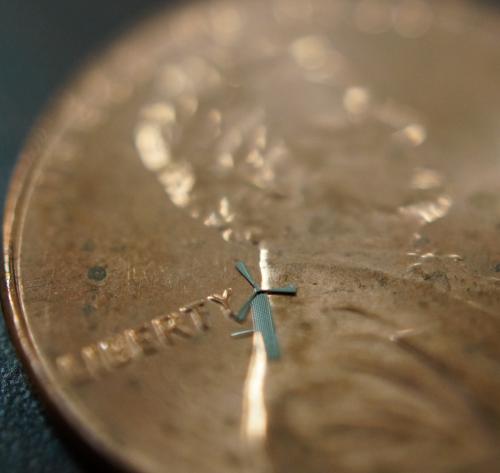Researchers at the University of Texas (Arlington) have taken the windmill and miniaturized it — so much so that it can actually be applied to one’s smartphone to serve as an emergency source of green power.

Now, while that description might seem a bit far-fetched, it is in fact what Smitha Roa and J.-C Chiao, the engineers behind this crazy concept, have done. Their micro-windmills measure approximately 1.8 mm in diameter — about the size of a pinhead. They were able to achieve this remarkable feat of design prowess by using flexible nickel alloy, and combining traditional origami concepts with conventional wafer-scale semiconductor device designs.
“The micro-windmills work well because the metal alloy is flexible and Smitha’s design follows minimalism for functionality,” Chiao explained.
Roa and Chiao came up with the idea while exploring green technology concepts on the smaller scale. Their design has been perfected to the point that they can fit 10 micro-windmills on a single grain of rice.
What’s more, the concept has proven so worthwhile that Taiwanese company WinMEMS Technologies Co. has already secured exclusive rights to commercialize the concept.
“The company was quite surprised with the micro-windmill idea when we showed the demo video of working devices,” Rao said. “It was something completely out of the blue for them and their investors.”
“It’s very gratifying to first be noticed by an international company and second to work on something like this where you can see immediately how it might be used,” said Rao. “However, I think we’ve only scratched the surface on how these micro-windmills might be used.”
See the tiny windmill in action in the video below:
The micro windmills were first successfully tested in September 2013, when the duo discovered that the windmill’s unique, aerodynamic design, coupled with the durable nickel alloy, allowed it to operate under strong artificial winds without fracturing.
“The problem most MEMS designers have is that materials are too brittle,” Rao said. “With the nickel alloy, we don’t have that same issue. They’re very, very durable.”
“Imagine that they can be cheaply made on the surfaces of portable electronics,” Chiao adds, “so you can place them on a sleeve for your smart phone. When the phone is out of battery power, all you need to do is to put on the sleeve, wave the phone in the air for a few minutes, and you can use the phone again.”
At present, an agreement has been established for UT Arlington to hold the intellectual properties while WinMEMS explores the commercialization opportunities.
UT Arlington has since applied for a provisional patent.
Story via uta.edu
Advertisement
Learn more about Electronic Products Magazine





